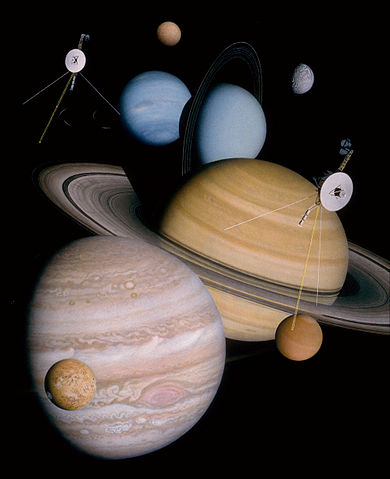
What will happen to the Voyager spacecraft? Unless they collide with anything, they will probably keep going for several billion years.
Voyager 1 is currently 24.3 billion km away from Earth and Voyager 2 is 20.3 billion km away. Despite being called number 2, Voyager 2 was launched in August 1977, a month before Voyager 1, which was launched in September 1977. Voyager 1 has travelled further because it flew past the largest moon of Saturn, Titan, and then headed directly for outer space. Voyager 2 was directed to pass far more planets, which slowed it down a lot. Voyager 2 flew by Jupiter in 1979, Saturn in 1981, Uranus in 1985, Neptune in 1989, and then headed out to outer space.
Both Voyagers are carrying a 12-inch gold-plated copper disk that is engraved with information about Earth and has sounds of Earth on it as well. The idea is that if an intelligent alien lifeform happened to come across the spacecraft, they could understand the information on the disk and know that another intelligent lifeform had sent it. They could trace the trajectory of the spacecraft back and come and find us. That is, of course, assuming that we still exist, or the Earth still exists at that time. The cover of the record has information engraved in it of how to play the record, how to see the pictures on it, and of the location of our solar system and the Earth. It also has an ultra-pure piece of uranium-238 on it, which has a half-life of 4.51 billion years. Any alien lifeform that found the disk could work out how much uranium was left and thereby work out how long the spacecraft had been flying for.
So, will the Voyager spacecraft still be flying in 4.51 billion years’ time? They probably will? Both Voyagers are now in interstellar space, which is the region of space that is outside of our heliopause. The sun constantly releases electrically charged particles that flow away from the sun, like the wake of a boat moving through water. These particles make a bubble around the solar system and on the other side of the bubble is the interstellar wind. Both Voyagers are on the other side of this and flying into Interstellar space. Interstellar space has a very low density, and they can fly for a long time without being eroded, as they would be on Earth. There are obviously particles in space, but they are a lot fewer and farther between.
To ensure the Voyagers can fly for billions of years, they need to completely get away from our solar system. They may be in interstellar space, but they still have to get through the Oort cloud, which is a bubble of ice and dust. The inner edge of the Oort cloud is about 300 billion km away and the outer edge is probably about 15 trillion km away. It is very thick and is full of pieces of ice that are the size of mountains and lots of space dust. However, the cloud is so large that it is not very dense and there are probably gaps of a hundred million km that both Voyagers will just fly through, although it will be probably 30,000 years from now before they are through it.
Once through the Oort cloud, the only thing that can damage the Voyager spacecraft is interstellar dust. Interstellar dust is comprised of silicates, which is very much like sand, and soot. These have probably come from the outer atmospheres of red giant stars. The dust is not very dense and the Voyager spacecraft won’t encounter much of it at any one time, but over billions of years, they will be hit by a lot and each piece will be travelling very quickly. The impact of a single grain could cause part of the spacecraft’s casing to be chipped away. However, the spacecraft aren’t under power. They are flying with their own momentum. Even if the space dust breaks them up int thousands of pieces, those pieces will continue to fly.
The thing that is most likely to stop them is an impact with a stellar body, such as a star or a planet. NASA has analyzed the route the spacecraft will take and there are no likely impacts for the next 500 million years, but there is no real way of knowing after that. The voyagers will be flying through areas of newly created stars and in 5 billion years, the Andromeda galaxy will impact the Milky Way galaxy and there will be a whole new host of stars that it could impact. However, if the spacecraft don’t hit a star, they could continue for many many billions of years. If they encounter a gas cloud, they could be eroded to nothing and become their own space dust, but probably some part of them will continue for a ridiculously long amount of time. And this is what I learned today.
Image By Don Davis – Donald Davis' official site, Public Domain, https://commons.wikimedia.org/w/index.php?curid=1684410
Sources
https://voyager.jpl.nasa.gov/mission/interstellar-mission/
https://voyager.jpl.nasa.gov/mission/status/
https://www.space.com/predicting-voyager-golden-records-distant-future
https://voyager.jpl.nasa.gov/frequently-asked-questions/fact-sheet/
https://en.wikipedia.org/wiki/Voyager_2
https://voyager.jpl.nasa.gov/golden-record/golden-record-cover/
https://science.nasa.gov/solar-system/oort-cloud/
https://jila.colorado.edu/~ajsh/courses/astr1120_03/text/chapter9/l9S1.htm

[…] Voyager 2 flew past Neptune, astronomers worked out that Neptune wasn’t as big as they had calculated. When […]